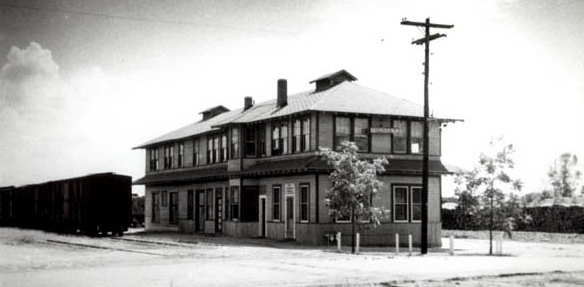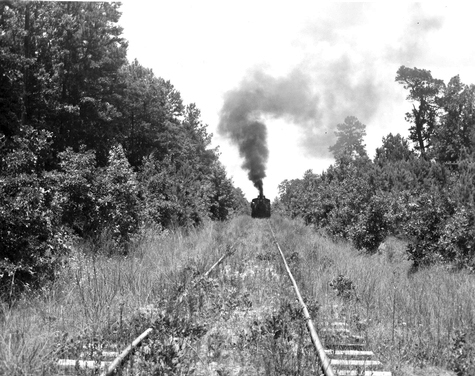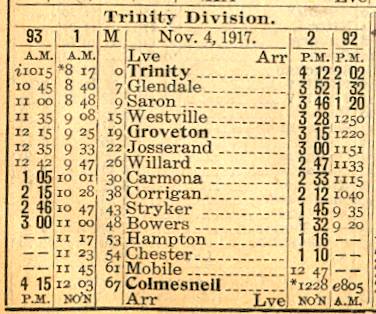|
|
||||||||||||||||||||||||||||||||||||||||||||||||||||||||||||||||||||||||||||||||||||||||||||||||||||||||||||||||||||||||||||||||||||
|
WBT&S History
WBT&S Trinity Depot & Offices
|
||||||||||||||||||||||||||||||||||||||||||||||||||||||||||||||||||||||||||||||||||||||||||||||||||||||||||||||||||||||||||||||||||||
|
The Wobbly is a wonderful representation of most East Texas short lines from
the boom of the 1880s to the Great Depression. Its story, like so many others,
began with exuberant optimism and ended with abandonment following a long, slow
decline and desperate struggle to keep it financially solvent. Today there's
almost nothing left of
this East Texas gem.
This essay isn't intended to be an in-depth study of the WBT&S, but rather a
concise history and a way to feature the media I have been able to locate over
the years.
Loggers along the route christened the line the “Wobbly, Bobbly, Turnover & Stop” because of its frequent derailments. That paints a rather vivid picture of what the railroad must have looked liked in its waning years! During prohibition days, bootleggers using the line gave it other nicknames, “Wine, Beer, Tequila & Shinny” and "Whiskey, Beer, Tobacco & Snuff." Housewives often called it the “Wash Board, Tub & Soap.” Still another sobriquet resulted from the train’s frequent delays: “Won’t be Back Til Saturday." The final variations noted are, "Wobblety, Bobblety, Turnover & Stop" and "Wobble, Bobble, Turnover & Stop." Local historians seem to agree that the first and most commonly used moniker was, and is, “Wobbly, Bobbly, Turnover & Stop.” I will simply, and affectionately, refer to it as "The Wobbly" for this website.
In 1913, the MKT merged the two railroads into a single system with the permission of the Texas Legislature. Neither branch ever connected with the "Katy" system and it became known as the "Orphan Division." The Katy later fell on hard times herself and the combined railroad was divested and purchased by the newly created Waco, Beaumont, Trinity & Sabine Railway Company on April 8, 1924. This new company was founded by Col. R. C. Duff, who hoped to extend the railroad to its intended cities of Waco and Beaumont and then on to the Sabine River. The WBT&S fell into receivership in February of 1930 due to the Depression, but remained independent until the end of operations in 1961. This was the longest receivership of a railroad in Texas history.
The business office remained in Trinity and the WBT&S operated 48 miles from Weldon through Trinity to Livingston (the Beaumont Division) and 67 miles between Trinity and Colmesneil (the Trinity Division). It never reached any of the locations in its title save its point of origin: Trinity. The Wobbly ran through the counties of Trinity, Polk, Tyler and Houston. The towns served included Colmesneil, Trinity, Mill Junction, Sequoyah, Barnes, Glendale, Groveton, Corrigan, Chester, Carlisle, Sebastopol, Pagoda, Onalaska, Pennell, Kickapoo, East Tempe, Vreeland, Blanchard, Luce, Livingston, West Livingston, Auburn, Weldon, and Kittrell.
Almost unbelievably, the Wobbly interchanged
with 4 railroads at 5 locations! That's not bad for a railroad that served an
area so sparsely populated. The International & Great Northern (later Missouri
Pacific and then Union Pacific) interchanged with the WBT&S at its corporate
headquarters in Trinity. The Groveton, Lufkin, & Northern was reached in
Groveton (Groveton itself would make an interesting story sometime down the
road). The Houston East & West Texas (known as "The Rabbit" and owned by SP, now
UP) was interchanged with at Livingston and Corrigan on the Beaumont and Trinity
Divisions respectively. And finally, the Texas & New Orleans (also owned by SP)
was reached at Colmesneil. During this period, at its peak, the WBT&S operated
115.2 miles of standard gauge, weed-infested, ballast-free track through the
thick piney woods of East Texas.
The Colmesneil section on the Trinity Division was the first to go in 1936.
The traffic had all but dried up. 1940 saw the 6 miles between Kittrell and
Weldon torn up. The 23 mile section from Luce to Livingston saw its last train
in 1949.
What remained of the WBT&S was torn up in 1961, except for the
segment between the Missouri Pacific Junction on the Beaumont Division and the
proposed waterline of the new Lake Livingston. The Trinity Chamber of Commerce
purchased this section for a proposed tourist line.
-Jason Rose (with assistance from Susan Madeley) |
||||||||||||||||||||||||||||||||||||||||||||||||||||||||||||||||||||||||||||||||||||||||||||||||||||||||||||||||||||||||||||||||||||
|
|
||||||||||||||||||||||||||||||||||||||||||||||||||||||||||||||||||||||||||||||||||||||||||||||||||||||||||||||||||||||||||||||||||||
|
Time Table Trains 14, 15, 17, 18
Beaumont Division
Trinity Division
Research Sources Model Railroader Magazine: July 1988 |
||||||||||||||||||||||||||||||||||||||||||||||||||||||||||||||||||||||||||||||||||||||||||||||||||||||||||||||||||||||||||||||||||||
|
|
||||||||||||||||||||||||||||||||||||||||||||||||||||||||||||||||||||||||||||||||||||||||||||||||||||||||||||||||||||||||||||||||||||
|
|
||||||||||||||||||||||||||||||||||||||||||||||||||||||||||||||||||||||||||||||||||||||||||||||||||||||||||||||||||||||||||||||||||||


